Fabric Paints for Art & Decoration
Fabric (textile) paints are suitable for application on both natural and synthetic fibers. The different colors can be mixed and overflowing to produce new shades. With the help of fabric paints you can easily cover up any defect and make it a spectacular decoration.
View more
Creative Tie-Dye Fabric Painting Set – 3 Vibrant Colors: Black, Blue & Green – Perfect for DIY Fashion and Textile Art

Tie-Dye Fabric Painting Set – 3 Bright Colors: Yellow, Turquoise & Orange – Perfect for Creative DIY Fashion, Art Projects, and Summer Fun

Premium Fabric Paint Set DOZEN – 12 Vibrant Colors x 12 ml – Soft, Wash-Resistant & Easy to Apply – Perfect for Painting on Fabric, Canvas, Denim and DIY Fashion Projects
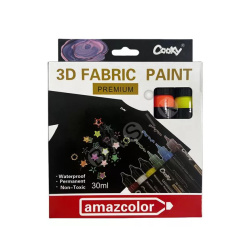
Fabric Paint Set, Rich Vibrant Colors - 6 Colors x 30 ml

Fabric Paint Set - 12 Colors x 10 ml, 1 Color Regulator 30 ml, and Brush Included
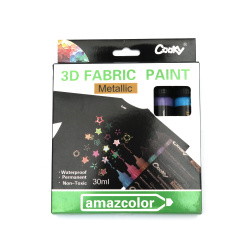
Set of Fabric Paints Metallic Colors - 6 Colors x 30 ml

Mont Marte Fabric Paint Sticks for Textile, 9 pcs

Mont Marte Fabric Paint Set, 12 Colors x 20 ml, Textile Paint Kit

Cadence Dora Metallic Red Textile Fabric Paint 50 ml – Color 1133 – Shimmer Finish for Clothing, T‑Shirts & DIY Fabric Crafts

CADENCE Fabric & Textile Spray Paint, Black (1190), 100 ml – Quick-Drying, Easy-Spray Nozzle for Fabric Design, DIY & Textile Art

CADENCE Art & Hobby Paints Fabric Spray Paint – 100 ml, Aubergine 1117 | Textile Spray for Clothing, T‑Shirts, Canvas & DIY Craft Projects

Cadence Your Fashion Textile Spray Paint, 100 ml – Sunshine Yellow (1102) Fabric Spray for Clothes, T‑Shirts & DIY Crafts

Cadence Fabric & Textile Spray Paint, 100 ml – Leaf Green 1113 | Vibrant Fabric Color for Clothing, Shoes, Canvas & DIY Crafts

Fabric & Textile Spray Paint 100 ml, CADENCE – Pink 1103 for Clothing, Shoes & DIY Crafts

Fabric Spray Paint, 100 ml, CADENCE – Orange 1105 | Non-Toxic Textile Color for Fabrics, T-Shirts, Denim, Canvas & DIY Crafts
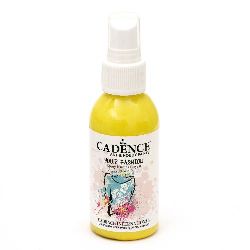
CADENCE Fabric and Textile Spray Paint, Vibrant Lemon Yellow 1101, 100 ml Aerosol Spray – Quick-Drying, Durable Finish for Clothing, T-Shirts, Upholstery and DIY Crafts

Fabric Spray Paint 100 ml, CADENCE – Grass Green (1112), Quick-Drying, Non-Toxic Textile Color for Various Fabrics (T-Shirts, Denim, Canvas, Upholstery) – Vibrant Finish

Fabric/Textile Spray Paint, CADENCE – Fuchsia 1104, 100 ml | Vibrant Fabric Color for T‑Shirts, Clothing, DIY Crafts, Fashion Design & Hobby Projects

Fabric Spray Paint 100 ml, CADENCE – Dark Turquoise 1116, Quick-Drying Textile Paint for T-Shirts, Clothing & Canvas, Ideal for DIY Crafts and Art Projects

CADENCE Fashion Textile Fabric Spray Paint – Purple 1120, 100 ml Spray Bottle, Clothing & DIY Crafts Spray Dye
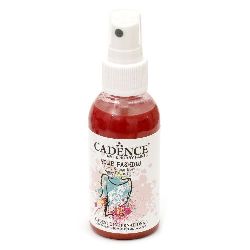
Cadence Fabric Spray Paint 100ml – Crimson 1106 Textile Spray for Clothes, T‑Shirts, DIY Fabric Art & Hobby Projects

CADENCE Fabric Spray Paint, Brown 1118 - 100 ml | Textile Paint for Fabrics, Clothing, T-Shirts & DIY Crafts

CADENCE Your Fashion Fabric Spray Paint 100 ml – Turquoise 1115 (Aqua Blue) Textile Spray for T‑Shirts, Clothing, Denim, Canvas & DIY Crafts

CADENCE Fabric Spray Paint 100 ml - Green 1111 Textile Color for DIY Crafts, Clothing, T-Shirts & Fabric Art
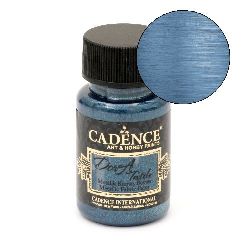
CADENCE DORA Metallic Fabric/Textile Paint, Sax Blue (1154) – 50 ml, Wash-Resistant, Easy to Use

Dora Metallic Textile Fabric Paint 50 ml, CADENCE – Pearl 1152, Shimmer Pearlescent Finish for Clothes, T-shirts, Cotton & Denim

Dora Metallic Fabric & Textile Paint, 50 ml, CADENCE – Petroleum (Teal) 1140, Shimmer Finish for Clothes, Denim, Canvas & DIY Crafts

Metallic Fabric & Textile Paint, CADENCE DORA - 50 ml – Orange 1156, Shimmer Finish for Clothes, T‑Shirts, Shoes & DIY Crafts
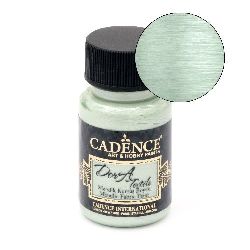
Dora Metallic Fabric/Textile Paint – Mint (1153), CADENCE - 50 ml Shimmer Finish for Fabric & Textile Art and DIY Crafts
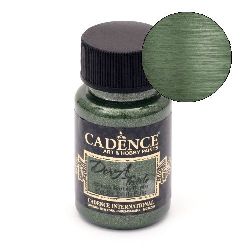
Cadence Dora Metallic Fabric Paint – Vibrant Green (1135), 50 ml, Shiny Metallic Effect for Textiles, T‑Shirts, Denim & Canvas

Dora Metallic Textile & Fabric Paint, CADENCE – White Gold Color 1148 (Gold-Tone), 50 ml

Dora Metallic Textile Paint, Rich Gold Color (Gold-Colored, Shade 1136), CADENCE – 50 ml – Fabric Paint for Clothing & DIY Craft Projects

Metallic Textile Paint, 50 ml, CADENCE DORA – Antique Gold Tone (1150), Gold-Colored Finish for Fabric, Clothing, T-Shirts, Denim & DIY Crafts

Cadence Dora Metallic Fabric Paint – Anthracite (1138), 50 ml – Textile Paint for Fabrics, Clothing & DIY Crafts
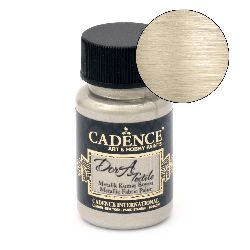
Dora Metallic Textile Fabric Paint, CADENCE – Platinum 1137 (Silver‑Tone), 50 ml | Metallic Finish for Fabric, Clothing, Denim, Cotton, DIY Crafts
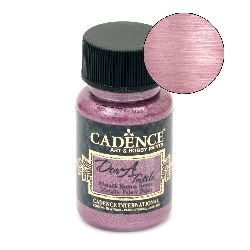
Dora Metallic Fabric & Textile Paint, 50 ml, Cadence – Vibrant Cyclamen 1144, High-Quality Shimmer Finish for Fabrics, Clothing and DIY Crafts

Dora Metallic Fabric Paint, Menthol 1146 (Mint), Cadence – 50ml Textile Paint with Shimmer Finish for Fabrics, Clothing & DIY Crafts

Cadence Dora Metallic Fabric & Textile Paint, Aqua 1145 (Light Blue), 50 ml – Shimmer Finish for Clothing, Denim, Canvas & DIY Fabric Crafts

DORA Metallic Fabric & Textile Paint, Aragonite 1124, CADENCE – 50 ml for DIY Crafts, Clothing, Denim & Shoes

Fabric Spray Paint, CADENCE – Sea Blue 1109, 100ml | Matte, Quick-Drying Textile Spray for Clothing, T-Shirts, Canvas, Stencils & DIY Crafts
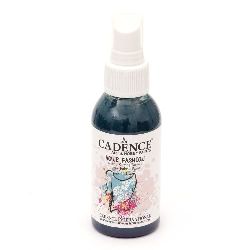
Premium Fabric/Textile Spray Paint 100ml, CADENCE – Petroleum 1114 (Petrol Blue), Quick-Drying, Long-Lasting Color for Cotton, Canvas, Denim & Other Textiles

Fabric/Textile Spray Paint, 100 ml. CADENCE Bordeaux 1108 – DIY Clothing, T‑Shirt & Craft Fabric Paint

Textile Fabric Spray Paint, CADENCE – Scarlet Red 1107, 100 ml | Fabric & Clothing Craft Color for DIY, T‑Shirts, Canvas, Stencils

CADENCE Textile Spray Paint 100 ml – Navy Blue (1110), Quick-Drying Fabric Spray for DIY Clothing, Bags & Decorative Art
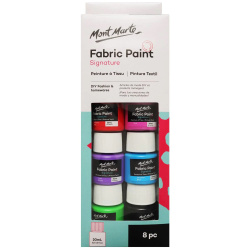
Mont Marte Fabric Paint Set, 8 Colors x 20 ml, Textile Paint Set

Fabric Spray Paint, White 1101, CADENCE – 100 ml Textile Color Spray for Fabric Design, DIY Clothing, T-Shirts & Crafts
Textile Paints
Textile paints for decoration and applied arts are used for overall dyeing of various types of fabrics and for painting and partial decorating on various textile products. They are extremely easy and convenient to use, and the incredible color palette allows for the creation of unique art designs.
The paints are suitable for application on natural and synthetic fibers, do not crack, have clean and saturated colors that fade slowly. Decorated fabrics can be washed and ironed from the reverse side of the painting.
Textile paint can be applied in different ways - with brushes, sponges, or rollers. It also allows for combination with other types of paints and decoration elements - sequins, beads, stones, etc.
Types of Textile Paints
- Cadence Dora Textile paint in convenient 50 ml jars. The color range offers 14 unique shades. Suitable for painting on all types of fabrics.
- Cadence Textile Spray Paint 100 ml in 20 amazing colors. Applicable on various fabrics. They can be used alone and in combination with other textile paints. The spray packaging allows painting with the help of a stencil.
- Textile Paint Set - 10 colors of 30 ml each. A selection of incredible colors that ideally combine with all kinds of fabrics.
Applications of Textile Paints
Painting on Fabrics
Painting on textile is one of the most pleasant and interesting activities that will bring you true pleasure, peace of mind, and complete satisfaction with the results.
This is a way to obtain completely new and unique clothes, bags, and shoes with very little cost.
Textile paints are the main material for decorating fabrics. With them, you can create original and individual inscriptions, pictures, and prints. They are extremely easy to use, resistant to washing, do not wear out, and do not crack.
When it comes to painting on textile, it is best to use cotton. Cotton is a natural material that is gentle on the skin and works best with colorful drawing materials. It allows the paint to spread evenly and stay on the surface for a longer time.
This does not mean that you cannot use textile paints on other fabrics. You can paint on silk, cotton mixed with elastane and polyester, as well as on wool.
Before you start working with the fabric, it is necessary to wash and iron it (if it allows ironing). Think about what exactly you want to do with the paints and choose the place where you want your stamp to be.
It is very important to stretch the fabric well, to have a smooth base on which to paint. For this purpose, you can use an ironing board or another hard surface where you will place the textile.
Once you are ready with the preparation of the basics, you can proceed to decorating.
Textile paints are suitable for creating various stamps - animals, plants, various figures, as well as inscriptions. In addition to individual images, you can color the entire surface of the fabric, creating the feeling of a natural print.
You have the opportunity to choose between paints in different colors and make interesting combinations. This type of colorful material is suitable for painting with the help of a stencil. Prepare a stencil with a stamp of your choice.
Use ready-made stencils or make them yourself, by printing your favorite images on a printer and using a utility knife or scissors to cut out the desired places that you will later use for printing.
Add different finer elements with the help of cutting dies and punches. The abundance of these cutting machines is very large and allows you to achieve great shapes - inscriptions, insects, birds, animals, and other interesting figures.
After you are ready with the stencil, place it in the desired place and start applying the paint. Apply as much quantity as you want to achieve the desired saturation of the picture.
The more paint you use, the denser and more colorful the image you will get at the end. If you want to achieve a very gentle picture, apply a thinner layer of it.
For application, use a brush or sponge, according to your personal preferences. Decide which way is more convenient for you. When applying, it is important that the paint does not go under the stencil, as this will ruin the shape of the picture you want to create.
With this method, you can decorate t-shirts, blouses, jeans, jackets, blazers, cardigans, tracksuits, sweatshirts, denim jackets, leggings, jeans.
Textile paints are extremely suitable for coloring shoes and sneakers made of fabric. With them, you will create incredibly stylish shoes that will perfectly complement your individual appearance. Use different colors and create unique decorations.
The method of work is the same. Make sure the surface you are going to paint on is clean. Choose the design you will create, and equip yourself with brushes of different sizes. Again, you can use stencils.
In addition to clothes and shoes, you can also decorate textile bags, clutches, and wallets. Very often, we can’t find a bag that matches clothes in a more unusual color. Textile paint will solve this problem extremely easily.
Choose a bag or wallet in a neutral, light shade and transform it with the help of colorful textile materials.
If you want to add additional shine and chic to your fashion accessory, use stones, glitter, sequins, ribbons, and lace, which you can sew onto them. This way, you can beautify any hand-painted garment.
Textile paints can completely change your personal style. With them, you will create the most original clothes, accessories, and home items, which you won’t find in any store. This is what makes them such a special and useful creative material.
In addition to creating new designs, textile paints can cover up a defect in a garment, such as a stain, burn, or small hole. By applying the colors to the fabric, you will turn the defect into an impressive decoration.
In addition to clothes and bags, the paint is suitable for painting pillowcases, tablecloths, curtains, and other textile products.
This way, you will change the home interior, ensuring that no one can replicate what you have created with your own hands and imagination.
Also, with the help of textile paints, you can make original decorations for various occasions - weddings, christenings, birthdays, Christmas, New Year, Easter, Valentine’s Day, bridal and bachelor parties, etc. Decorating tablecloths and curtains is suitable when making festive decorations.
If you are wondering how to decorate wedding chairs, for example, make covers by dyeing them with beautiful shades of the paints. You can match the colors with the overall festive decor. In the same way, you can beautify the tablecloths and curtains, if any.
The abundance of all kinds of blending shades will allow you to create the most attractive decoration. Surely, every guest will be impressed by the event you have organized.
Mixed Media
Mixed media is a type of art concept developed in the 20th century. It occurs when postmodern artists begin to link traditional arts - sculpture and painting.
Mixed media is found in every creative product that uses more than one or two types of materials.
Since this is a mixed technique, textile paints can also be used in it if your projects include textile cutouts and elements that you will color.
Today, this type of art is used by professional artists and hobbyists. It creates various cards, souvenirs, collages, paintings, panels, and decoupage.
Characteristic of mixed media is that all kinds of materials are used, not just classic paints, cardboard, and pencils.
For the creation of various art objects, this technique includes different types of paints, fabric, leather, cardboard, beads, stones, buttons, coins, cutlery, dry leaves , bolts, screws, various small metal, plastic, and wooden elements and many others.
The use of punches, stencils, and border scissors is highly characteristic to achieve additional ornamentation of individual parts of the mixed product.
Mixed media is truly a very rich and interesting art form. The resulting art creations are impressive, unique, and extremely beautiful.
Making Stage Decorations
If you are a fan of theatrical art, you have surely noticed that there is no performance without some stage decor. Textile paint is one of the most convenient ways to make theatrical decorations. With it, you can quickly and easily transform any item made of fabric.
Pillowcases, tablecloths, cloaks, the clothes of the actors, and the curtains. When it comes to theater, the time for preparing the stage setting is limited. That’s why textile paints are extremely suitable and would quickly come in handy for the actors.
It is important to know a few things about textile paints. When painting and dyeing fabrics, the following things matter:
-
Type of Textile
The type of fabric you are going to paint on is of great importance for the final result. Before choosing textile, it is important to know its composition and whether it contains synthetic fibers. It is possible that the dyeing of the fabric will not be successful precisely because of its composition.
Textile paints can be used on - pure cotton, cotton with lycra, wool, linen, polyester.
-
Color of the Base
The color of the fabric you want to dye is important. Lighter fabrics are easier to dye. You can paint different elements and figures on them.
Darker textiles are more difficult to process with colorful materials, unless you use light tones that will stand out on the dark base.
Match the shade of the fabrics with that of the paints to achieve better contrast and brightness of the drawing.
The abundance of colors in textile paints allows for unique combinations on all surfaces of cotton, wool, linen, silk, and polyester.
-
Quantity of Paint
If you are wondering how much paint to use, the packaging shows the amount of fabric that can be dyed with a certain amount of it. This way, you can understand how much paint you will need.
-
Process of Painting
There are two main ways to paint on textiles. One is on a stove, and the other is with a washing machine.
-
Additives to the Color Material
If you are painting on wool or silk, you can add vinegar to the paint. Different types of paints have individual usage instructions.
There are several techniques for painting on textiles:
1: Dry Technique
In the dry technique, the color material is applied with a brush or sponge on a dry surface. This results in a saturated painting with clearly defined outlines.
2: Dry Sponge
In the dry sponge technique, the paints are applied with the help of a stencil, with the sponge being dabbed through it.
It is suitable for making inscriptions and various pictures. It is even used by people who cannot draw.
If you want to make fine details, use a dry roller. It prevents the paint from penetrating under the edges of the stencil.
3: Wet Technique
In the wet technique, the base is pre-wetted, and a lot of water is also used to apply the paint. This method results in more blurred and airy images and painting in one go with great sweep. This way, you can create flowers, picturesque paintings, and fairy tales.
The fabric you create on will definitely become unique and unrepeatable. In this technique, contours are often used to emphasize the images.
Important Recommendations:
Before you start using textile paints, you need to prepare the fabric you will work with. It must be clean and degreased so that the paint adheres tightly and does not peel off later.
The next step in preparing the fabric is to iron and stretch it well so that you can paint without it bending and wrinkling under your hands.
Last but not least, before opening the paints, shake the containers well, to mix the pigments in the tubes.
If you are one of the creators who have not yet touched the magic of textile paints, do not miss to do so.
To familiarize yourself with the ways of working with the material, look for artist guides and videos made by hobbyists, where you will find valuable information about this type of paint.
You will see for yourself how easy they are to use and you will fall in love with the final results you will achieve with them.
Prices
At the online store EM ART, we strive to maintain low and affordable prices for our customers. We often make discounts from the regular prices of the items.
The price of the products in the category depends on the type and quantity of the packaging in which it is offered.
Why EM ART?
EM ART is the most richly stocked online store for hobby materials. With us, you will find everything you need for your creativity – all kinds of working tools, all kinds of beads, various types of paper, cardboard, jewelry accessories, decoration materials, and gift packaging at affordable prices.
All items are made of high-quality and safe materials.
We often make discounts on various items, which every customer can take advantage of.
With us, you can shop wholesale and retail. For wholesale traders, we have preferential prices.
Delivery
After you have chosen the necessary hobby materials, you need to enter your personal details – three names, a contact phone number, and an address where you want to receive your package.
Expect your order to arrive within a few working days.
For orders worth over 100 BGN, delivery is completely free.
If you have any questions, you can contact our online consultants, who are at your disposal every day from Monday to Saturday from 9:30 to 18:30.
Indulge yourself in inspiration and make your most unique projects a reality!
